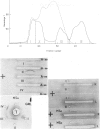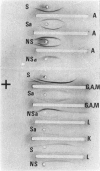Abstract
An immunochemical characterization of salivary immunoglobulins from ten patients with multiple myeloma was undertaken. Seven of the patients had IgA monoclonal components and their transfer to saliva could be proved immunochemically in five. Three salivas containing monoclonal IgA were fractionated by gel filtration on Sephadex G-200, and secretory component could be detected in the same peaks as the monoclonal IgA. Molecular size studies by electrophoresis in sodium dodecyl sulphate–polyacrylamide gel showed that in most salivas oligomeric forms of IgA were exclusively or predominantly detected. These findings suggest that oligomeric IgA of systemic origin might be as effectively transferred to external secretions as oligomeric IgA of regional origin. Of the three remaining patients, two had IgG monoclonal proteins that could be detected in concentrated saliva, while the monoclonal component of the last patient was of light chain type. In this last patient no free light chains were detected in concentrated saliva, but normal IgA as well as an apparently increased amount of polyclonal IgG were evident.
Full text
PDF









Images in this article
Selected References
These references are in PubMed. This may not be the complete list of references from this article.
- Brandtzaeg P. Human secretory immunoglobulins. II. Salivary secretions from individuals with selectively excessive or defective synthesis of serum immunoglobulins. Clin Exp Immunol. 1971 Jan;8(1):69–85. [PMC free article] [PubMed] [Google Scholar]
- CUMMINGS N. A., FRANKLIN E. C. ATYPICAL GAMMA-1-A-GLOBULIN WITH THE ELECTROPHORETIC PROPERTIES OF AN ALPHA-2-GLOBULIN OCCURRING IN MULTIPLE MYELOMA. J Lab Clin Med. 1965 Jan;65:8–17. [PubMed] [Google Scholar]
- Fahey J. L. HETEROGENEITY OF MYELOMA PROTEINS. J Clin Invest. 1963 Jan;42(1):111–123. doi: 10.1172/JCI104688. [DOI] [PMC free article] [PubMed] [Google Scholar]
- GRABAR P., WILLIAMS C. A. Méthode permettant l'étude conjuguée des proprietés électrophorétiques et immunochimiques d'un mélange de protéines; application au sérum sanguin. Biochim Biophys Acta. 1953 Jan;10(1):193–194. doi: 10.1016/0006-3002(53)90233-9. [DOI] [PubMed] [Google Scholar]
- Kagnoff M. F., Serfilippi D., Donaldson R. M., Jr In vitro kinetics of intestinal secretory IgA secretion. J Immunol. 1973 Jan;110(1):297–300. [PubMed] [Google Scholar]
- LEVIN W. C., RITZMANN S. E., SEEUWEN J. P., NANNINGA L. SOME PROPERTIES OF BETA-2A-MYELOMA PROTEINS. Clin Chim Acta. 1964 Jul;10:12–20. doi: 10.1016/0009-8981(64)90209-8. [DOI] [PubMed] [Google Scholar]
- Parkhouse R. M., Virella G., Dourmashkin R. R. Structural characterization of a human monoclonal IgA protein. Clin Exp Immunol. 1971 Apr;8(4):581–591. [PMC free article] [PubMed] [Google Scholar]
- Strober W., Blaese R. M., Waldmann T. A. The origin of salivary IgA. J Lab Clin Med. 1970 May;75(5):856–862. [PubMed] [Google Scholar]
- Summers D. F., Maizel J. V., Jr, Darnell J. E., Jr Evidence for virus-specific noncapsid proteins in poliovirus-infected HeLa cells. Proc Natl Acad Sci U S A. 1965 Aug;54(2):505–513. doi: 10.1073/pnas.54.2.505. [DOI] [PMC free article] [PubMed] [Google Scholar]
- TOMASI T. B., Jr, TAN E. M., SOLOMON A., PRENDERGAST R. A. CHARACTERISTICS OF AN IMMUNE SYSTEM COMMON TO CERTAIN EXTERNAL SECRETIONS. J Exp Med. 1965 Jan 1;121:101–124. doi: 10.1084/jem.121.1.101. [DOI] [PMC free article] [PubMed] [Google Scholar]
- Thomasi T. B., Jr Secretory immunoglobulins. N Engl J Med. 1972 Sep 7;287(10):500–506. doi: 10.1056/NEJM197209072871008. [DOI] [PubMed] [Google Scholar]
- VAERMAN J. P., JOHNSON L. B., MANDY W., FUDENBERG H. H. MULTIPLE MYELOMA WITH TWO PARAPROTEIN PEAKS: AN INSTRUCTIVE CASE. J Lab Clin Med. 1965 Jan;65:18–25. [PubMed] [Google Scholar]
- Vaerman J. P., Fudenberg H. H., Vaerman C., Mandy W. J. On the significance of the heterogeneity in molecular size of human serum gamma A-globulins. Immunochemistry. 1965 Sep;2(3):263–272. doi: 10.1016/0019-2791(65)90006-6. [DOI] [PubMed] [Google Scholar]
- Virella G., Howard A. Correlation between electrophoretic mobility and heavy chain sub-classes of residual IgG from patients with severe hypogammaglobulinaemia. Experientia. 1970 Aug 15;26(8):901–903. doi: 10.1007/BF02114250. [DOI] [PubMed] [Google Scholar]







